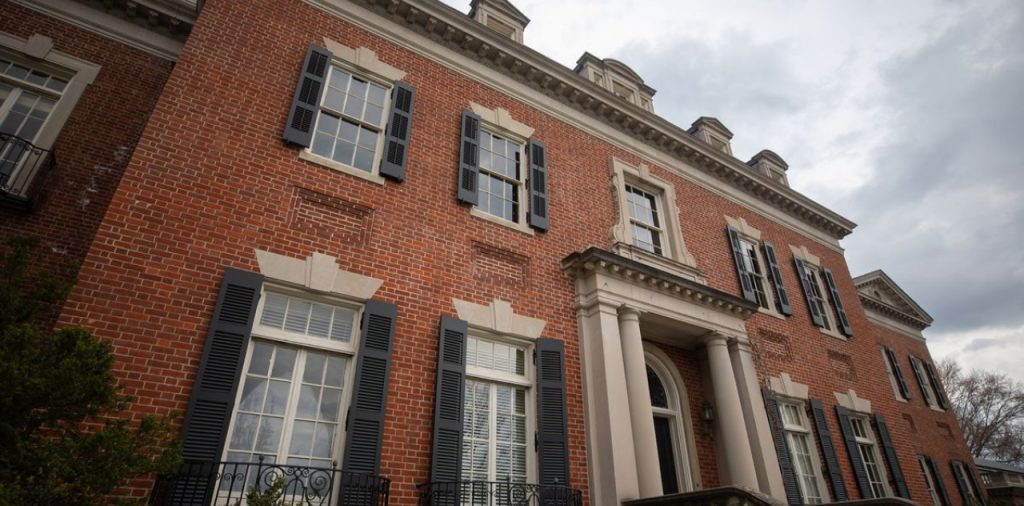If you want a unique and enriching experience in the nation’s capital, you should take advantage of the Dumbarton Oaks Museum. This museum is in a historic estate in the Georgetown neighborhood, and it showcases specialized collections of Byzantine and Pre-Columbian art, as well as Western medieval and Renaissance art and furniture. In this blog post, I will tell you more about the history, cultural significance, points of interest, exciting facts, and advice for visitors of this fantastic museum.

History
The Dumbarton Oaks Museum was founded by Robert Woods Bliss and his wife, Mildred Barnes Bliss, avid collectors and patrons of art and scholarship. They bought the estate in 1920 and transformed it into a beautiful residence and garden, where they hosted many distinguished guests and events. They also amassed a remarkable collection of art objects from different cultures and periods, which they displayed in their home.
In 1940, they donated their estate and collections to Harvard University to create a research center for Byzantine, Pre-Columbian, and Garden and Landscape studies. Since then, the museum has been open to the public and has expanded its exhibitions, programs, and publications.
Culture Significance
The Dumbarton Oaks Museum is one of the few places to see such a diverse and exquisite art collection from different civilizations and periods. The Byzantine collection features over 1,200 objects, including icons, mosaics, manuscripts, jewelry, textiles, and sculptures.
The Pre-Columbian collection consists of more than 500 objects from Mesoamerica, Central America, and the Andes, ranging from ceramics and stone carvings to gold and silver ornaments. The Music Room displays Western medieval and Renaissance art and furniture and paintings by El Greco, Goya, Renoir, Cézanne, and others.
The museum also hosts special exhibitions that explore various themes and topics related to its collections. For example, in 2023, you can see “Garden and Nature in the Medieval World,” which examines how gardens were depicted and used in medieval art and literature, or “Contemporaries: Twentieth-Century Painting at Dumbarton Oaks,” which showcases paintings by modern artists who were influenced by or connected to the Blisses.
Points of Interest
Some of the highlights of the museum include:
The Byzantine Cross
It is a gold cross with cloisonné enamel that dates back to the 10th or 11th century. It is one of the finest examples of Byzantine metalwork and shows scenes from the life of Christ.
The Aztec Calendar Stone
This piece is a carved stone disk representing the Aztec cosmology and calendar system. It was made in the late 15th or early 16th century and weighs about 24 tons.
The Robert Woods Bliss Collection of Pre-Columbian Art
The collection is considered one of its most important private collections. It includes objects from various cultures, such as the Maya, Teotihuacan, Olmec, Zapotec, Mixtec, Toltec, Aztec, Inca, Moche, Chavín, Nazca, Paracas, Tiwanaku, Wari, Lambayeque, Chimu, Chancay, and Muisca.
The Music Room
Lawrence Grant White designed the room in 1928 as a space for musical performances and social gatherings. It features a Steinway grand piano used by many famous musicians who visited Dumbarton Oaks.
The Garden
It was created as a collaboration between Beatrix Farrand and Mildred Bliss. It comprises sixteen acres of terraced gardens and vistas, orchards and kitchen gardens, and a vast wilderness of meadows and wooded pathways. It is one of the finest examples of American landscape architecture and a place of beauty and tranquility.
Interesting Facts
Here are some interesting facts about the Dumbarton Oaks Museum that you might not know:
- The name “Dumbarton Oaks” comes from two sources: “Dumbarton,” which was the name of an original land grant on the site, and “The Oaks,” which was added by one of the previous owners who planted oak trees on the property.
- The Dumbarton Oaks Museum was the site of an essential diplomatic conference in 1944, where representatives from China, the Soviet Union, the United Kingdom, and the United States met to discuss the formation of the United Nations.
- The Dumbarton Oaks Museum has a research library contains more than 200,000 volumes and rare books on Byzantine, Pre-Columbian, and Garden and Landscape studies.
- The Dumbarton Oaks Museum has an online platform provides access to its collections, publications, and resources. You can browse the objects, view high-resolution images, read scholarly essays, and download digital publications.
Advice for Visitors
If you are planning to visit the Dumbarton Oaks Museum, here are some tips to make your experience more enjoyable:
- The museum is open from Tuesday to Sunday, from 11:30 a.m. to 5:30 p.m. The garden is open from Tuesday to Sunday, from 2:00 p.m. to 6:00 p.m. The museum and the park are closed on Mondays and major holidays.
- The admission fee is $10 for adults, $8 for seniors and students, and free for children under 12 and Harvard ID holders. You can buy tickets online or at the museum entrance.
- You can take a guided tour of the museum or the garden or explore them independently. The tours are offered on a first-come, first-served basis and are subject to availability. The museum tours last about an hour and are provided at 2:15 p.m. on weekdays and at 11:45 a.m. and 2:15 p.m. on weekends. The garden tours last about 90 minutes and are provided at 2:00 p.m. on weekdays and at 10:30 a.m. and 2:00 p.m. on weekends.
- You can also take a self-guided audio tour of the garden, available in English, Spanish, French, German, Mandarin, and Arabic. You can download the app or borrow a device at the museum entrance.
- You should wear comfortable shoes and clothing suitable for the weather and the terrain. The garden has steep slopes and uneven paths, so be prepared for some walking and climbing.
- The museum and the garden are family-friendly, but an adult must always accompany children. There are some interactive activities and games for children in the museum, such as puzzles, coloring books, and scavenger hunts.
- The best time to visit the museum and the garden depends on your preference and interest. Depending on the season and the exhibition schedule, you can see different artworks and plants throughout the year. You can check the website for more information on what’s on display.
Trip drive through Washington D.C. : From Washington National Cathedral to Avesta Ketamine
Direction 1: Washington National Cathedral
3101 Wisconsin Ave NW, Washington D.C. 20016, United States
- Head east on Woodley Rd NW toward 36th St NW (0.2 mi)
- Turn left onto 34th St NW (0.5 mi)
- Continue onto Reno Rd NW (0.2 mi)
- Turn right onto Tilden St NW (0.7 mi)
- Turn left onto Linnean Ave NW (0.2 mi)
- Turn right, Destination will be on the right (0.1 mi)
Direction 2: Hillwood Estate, Museum & Gardens
4155 Linnean Ave NW, Washington D.C. 20008, United States
- Take Linnean Ave NW to Tilden St NW (2 min, 0.3 mi)
- Head southwest toward Linnean Ave NW (0.1 mi)
- Turn left onto Linnean Ave NW (0.2 mi)
- Continue on Tilden St NW. Take 34th St NW to Observatory Cir NW (7 min, 1.9 mi)
- Turn right onto Tilden St NW (0.7 mi)
- Sharp left onto Reno Rd NW (0.3 mi)
- Continue onto 34th St NW (1.0 mi)
- Turn right onto Massachusetts Ave NW (240 ft)
- Continue on Observatory Cir NW to Wisconsin Ave NW (2 min, 0.4 mi)
- Turn left onto Observatory Cir NW (0.2 mi)
- Continue onto Calvert St NW (0.1 mi)
- Turn left onto Wisconsin Ave NW
- Pass by FedEx Office Print & Ship Center (on the right) (3 min, 0.6 mi)
- Continue on South St NW
- Drive to 32nd St NW (1 min, 0.2 mi)
- Turn left onto South St NW (0.2 mi)
- Turn right onto 32nd St NW
- Destination will be on the left (210 ft)
Direction 3: Dumbarton Oaks Museum
1703 32nd St NW, Washington D.C. 20007, United States
- Take 34th St NW to M St NW (5 min, 0.8 mi)
- Head south on 32nd St NW toward R St NW (154 ft)
- Turn right onto R St NW (0.2 mi)
- Turn left onto 34th St NW (0.6 mi)
- Take Francis Scott Key Bridge/Key Bridge, Fort Myer Dr/N Ft Myer Dr, I-66 E, Exit 75 and VA-110 S to N Marshall Dr in Arlington (4 min, 1.4 mi)
- Use the right 2 lanes to turn right onto M St NW (233 ft)
- Use the left 2 lanes to turn left onto Francis Scott Key Bridge/Key Bridge (Entering Virginia, 0.3 mi)
- Continue onto Fort Myer Dr/N Ft Myer Dr (0.2 mi)
- Turn left onto Langston Blvd (489 ft)
- Use the right 2 lanes to take the ramp to I-395/Roosevelt Brg (0.2 mi)
- Merge onto I-66 E (0.2 mi)
- Take exit 75 for VA-110 S toward I-395/US-1/Pentagon City/Crystal City/Reagan Nat’l Arpt/Alexandria (0.2 mi)
- Continue onto VA-110 S (0.2 mi)
- Follow N Marshall Dr to Iwo Jima Acc Rd/U.S. Marine Corps War Memorial Access Rd (21 sec, 456 ft)
- Turn right onto N Marshall Dr (417 ft)
- Turn right onto Iwo Jima Acc Rd/U.S. Marine Corps War Memorial Access Rd (39 ft)
Direction 4: US Marine Corps War Memorial
Arlington, VA 22209, United States
- Get on US-50 E/Arlington Blvd from N Marshall Dr and N Meade St (2 min, 0.6 mi)
- Head south on Iwo Jima Acc Rd/U.S. Marine Corps War Memorial Access Rd toward N Marshall Dr (39 ft)
- Turn right onto N Marshall Dr (0.2 mi)
- Turn right onto N Meade St (0.2 mi)
- Take the ramp onto US-50 E/Arlington Blvd (0.1 mi)
- Take I-66 E to L St NW in Washington D.C. (4 min, 1.8 mi)
- Merge onto US-50 E/Arlington Blvd (0.1 mi)
- Keep left at the fork, follow signs for US-50 E/Washington D.C. and merge onto I-66 E (Entering District of Columbia, 0.8 mi)
- Use the left lane to take the I-66 E exit toward E Street (0.1 mi)
- Keep left, follow signs for Whitehurst Freeway (453 ft)
- Continue onto I-66 E (0.4 mi)
- Use the right lane to take the Whitehurst Frwy exit (0.1 mi)
- Keep right, follow signs for Pennsylvania Avenue and merge onto L St NW (0.2 mi)
- L St NW turns right and becomes Pennsylvania Avenue NW (154 ft)
- Slight left onto L St NW (2 min, 0.2 mi)
- Turn left onto New Hampshire Ave NW (4 min, 0.5 mi)
- At Dupont Cir NW, take the 4th exit onto P St NW (4 min, 0.4 mi)
- Turn right onto 16th St NW (16 sec, 164 ft)
- Turn right, Destination will be on the right (5 sec, 69 ft)
Direction 5: Avesta Ketamine and Wellness
1400 16th St NW Suite 101, Washington D.C. 20036, United States
